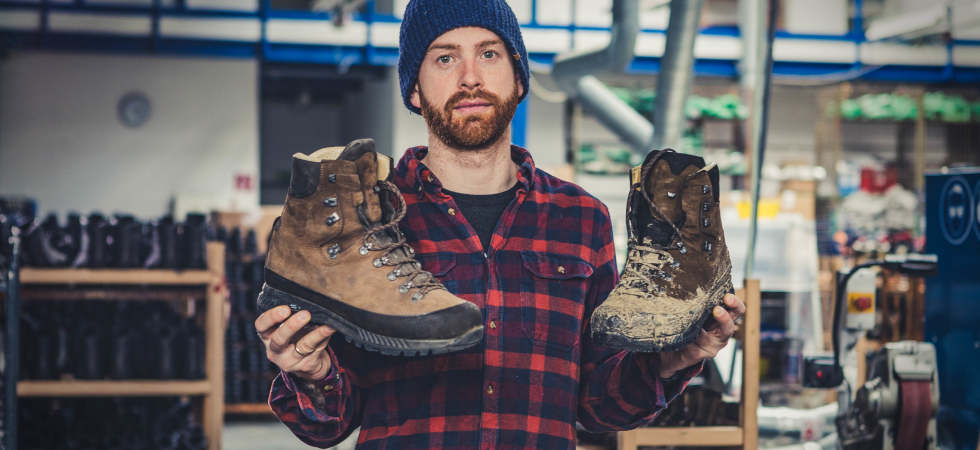Regular care of your hiking boots will not only keep them in good working order and prolong their life, it will also save you money. After all, mountain and hiking boots are rugged companions that, thanks to their materials and construction, are designed to accompany you on your adventures for a long time. But you can only really enjoy your boots for a long time if you give them the love and care they deserve.
That’s why we asked Hanwag, the Bavarian footwear specialist with over 100 years of experience: What are the most important steps in shoe care? Little spoiler: It’s easier than you think!
Hiking boot care in three steps:
- Clean mountain and hiking boots according to instructions
- Give it time: the drying process
- The right care
First step: cleaning hiking boots
After a beautiful hike, your mountain boots should not disappear in the car or in a damp cellar. The shoes have experienced and taken a lot with them on the last excursion – above all: Dirt. How often should you clean them? Ideally, after every hike, but in the case of light dirt after a dry day, it isn’t necessary to clean them over all.

What to do in case of dirt and moisture?
Dirt will not go away on its own and will damage your shoes in the long run, so it is wise to take care of it yourself. First, remove the laces and insoles to get to the hard-to-reach places.
A simple shoe brush is sufficient for cleaning, for stubborn incrustations you can use lukewarm water. Important: Do not use hot water! This will only damage the leather. You can simply run the water over the shoe or fill a small tub. Pay attention to the tongue of the shoe, as dirt particles such as needles, stones, or dust often accumulate there. You will only need a special leather cleaner if the shoe is very dirty, when brushing and lukewarm water does not work.
For cleaning the inside, you need the following utensils:
- For leather: a sponge
- For a textile interior: a lint-free cloth
- Lukewarm water
Use the sponge or cloth to wipe out the dirt from the toe box along the shoe opening.
The insole can typically be washed by hand – please follow the manufacturer’s instructions! If the insole is made of leather, cleaning with a damp cloth is sufficient.
A summary of the above steps can be found here from HANWAG:
Second step: Drying phase
After you have cleaned your shoes, you should let them dry slowly. Take your time, because drying too quickly or incorrectly will damage the leather.
Important: Do not leave wet or damp shoes in direct sunlight. Artificial heat from a radiator or oven is usually very damaging to the leather. The drying process should be as slow as possible.
For the impatient: You can speed up the process by placing a piece of paper in the front of the toe box of the shoe and changing the wipes periodically. This is a great way to get the moisture out of your shoes, especially on multi-day trips.
If you have problems with stinky feet and your shoes tend to smell, you can simply use a shoe deodorant after drying.
Third step: Hiking boot care
In case of bad leather condition:

You can always judge the condition of the leather optical. As soon as it looks dry and brighter than when you bought it, it is time to act. You will need a pure shoe wax and a microfiber cloth. Please do not use grease or oil as this will clog the pores of the leather and impair the function. In addition, it can cause the leather to take on other properties that are not beneficial for your next hike. Spread the wax thoroughly with a cloth so that the shoe doesn’t look too greasy, but regains its original vibrant color. Check to make sure you really got all spots!
If you want to save time and effort, you can use the Care Sponge product developed by HANWAG. It is a 2-in-1 product that provides the leather with wax and at the same time forms a protective layer. This prevents water from adhering to the leather as a film. As with waterproofing, the water beads off. The product is applied with the integrated brush on the neck of the product.

In case of good leather condition:
Never wrong: Reproofing. It almost doesn’t matter which spray you use. However, it is important that it is suitable for leather shoes. So make sure before you buy! Always spray from a distance of about 30 centimeters. Spraying too close will stain the upper. Too far away and the spray will have no effect. Check yourself to make sure you have gotten all the spots. This is the only way to get the best protection! This is usually given about 24 hours after application.
Here is the short version as a video from HANWAG:
Quick Run/Overview:
- Always clean your shoes after each hike
- Do not use harsh detergents or similar products for cleaning
- Leave to dry in a shaded, well-ventilated area
- Never dry or store on or near a heater or stove
- Treat leather with shoe wax only, followed by waterproofing spray
- Storage: Also in a well-ventilated, dry and shaded place
- Correct (=dry) storage prevents premature hydrolysis of the midsole

We thank HANWAG for the perfect instructions on how to give your shoes some extra love. For more tips and tricks, check out the HANWAG website.
Can’t get enough of our guides? Be sure to check them out now:
→ Have hiking and climbing shoes resoled: This is how it works
→ Forget blisters with the right pair of hiking socks
→ How to find the perfect fitting outdoor boot
→ Hiking and Trekking poles: Faithful companions in the Mountains









